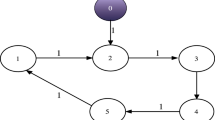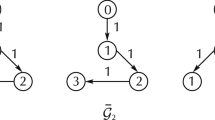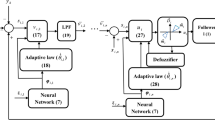Abstract
This paper studies distributed singularity-free finite-time consensus tracking control for quite a large class of high-order (powers are positive odd integers) nonlinear multi-agent networks in the presence of unknown asymmetric dead zone. Achieving finite-time consensus tracking for such dynamics is extremely challenging because feedback linearization and backstepping methods successfully developed for low-order systems fail to work, and some appropriate exponential terms typically arising from finite-time stability are difficult to design due to the existence of high powers and strong couplings among distinct agents. To this purpose, an adding-one-power-integrator methodology is skillfully incorporated into the finite-time stability theory so as to stabilize the closed-loop system. Over the course of design, a variable-separable lemma is utilized to extract the unknown asymmetric dead-zone input in a “linear-like” manner and fuzzy logic systems are utilized to estimate the unknown system continuous nonlinearities over some compact sets. The singularity issue typical of finite-time control is overcome by delicately introducing a switching function. It is rigorously proved that the consensus tracking error eventually converges to a residual set, whose size can be made as small as desired, in finite time, while guaranteeing the boundedness of all closed-loop signals. Comparative simulations are finally provided to verify the effectiveness of the presented scheme on the existing control methods.





Similar content being viewed by others
Data availability
Data sharing is not applicable to this article as no datasets were generated or analyzed during the current study.
References
Ren, W., Chao, H.Y., Bourgeous, W., Sorensen, N., Chen, Y.Q.: Experimental validation of consensus algorithms for multivehicle cooperative control. IEEE Trans. Control Syst. Technol. 16(4), 745–752 (2008)
Wu, L.B., Park, J.H., Xie, X.P., Ren, Y.W., Yang, Z.C.: Distributed adaptive neural network consensus for a class of uncertain nonaffine nonlinear multi-agent systems. Nonlinear Dyn. 100, 1243–1255 (2020)
Haghshenas, H., Badamchizadeh, M.A., Baradarannia, M.: Containment control of heterogeneous linear multi-agent systems. Automatica 54, 210–216 (2015)
Liu, D.C., Liu, Z., Chen, C.L.P., Zhang, Y.: Distributed adaptive neural control for uncertain multi-agent systems with unknown actuator failures and unknown dead zones. Nonlinear Dyn. (2020). https://doi.org/10.1007/s11071-019-05321-x
Wang, W., Liang, H.J., Zhang, Y.H., Li, T.S.: Adaptive cooperative control for a class of nonlinear multi-agent systems with dead zone and input delay. Nonlinear Dyn. 96, 2707–2719 (2019)
Liang, H.J., Zhang, Y.H., Huang, T.W., Ma, H.: Prescribed performance cooperative control for multiagent systems with input quantization. IEEE Trans. Cybern. (2019). https://doi.org/10.1109/TCYB.2019.2893645
Lv, M.L., Schutter, B.D., Yu, W.W., Baldi, S.: Adaptive asymptotic tracking for a class of uncertain switched positive compartmental models with application to anesthesia. IEEE Trans. Syst., Man, Cybern., Syst. (2019). https://doi.org/10.1109/TSMC.2019.2945590
Wang, H., Yu, W.W., Ding, Z.T., Yu, X.H.: Tracking consensus of general nonlinear multiagent systems with external disturbances under directed networks. IEEE Trans. Autom. Control 64(11), 4772–4779 (2019)
Guo, X.Y., Liang, H.J., Pan, Y.N.: Observer-based adaptive fuzzy tracking control for stochastic nonlinear multi-agent systems with dead-zone input. Appl. Math. Comput. 379, 1–22 (2020)
Liang, H.J., Liu, G.L., Huang, T.W., Lam, H.K., Wang, B.H.: Cooperative fault-tolerant control for networks of stochastic nonlinear systems with nondifferential saturation nonlinearity. IEEE Trans. Syst., Man, Cybern., Syst. (2020). https://doi.org/10.1109/TSMC.2020.3020188
Krstic, M., Kanellakopoulos, I., Kokotovic, P.: Nonlinear and Adaptive Control Design. Wiley, New York, USA (1995)
Wang, N., Wen, G.H., Wang, Y., Zhang, F., Ali, Z.: Fuzzy adaptive cooperative consensus tracking of high-order nonlinear multi-agent networks with guaranteed performances. IEEE Trans. Cybern. (2021). https://doi.org/10.1109/TCYB.2021.3051002
Qian, C.J., Lin, W.: Output feedback control of a class of nonlinear systems: a nonseparation principle paradigm. IEEE Trans. Autom. Control 47(10), 1710–1715 (2002)
Lin, W., Qian, C.J.: Adding one power integrator: a tool for global stabilization of high-order lower-triangular systems. Syst. Control Lett. 39, 1339–1351 (2000)
Sun, Z.Y., Zhang, X.H., Xie, X.J.: Global continuous output-feedback stabilization for a class of high-order nonlinear systems with multiple time delays. J. Frankl. I. 351(8), 4334–4356 (2014)
Zhang, L., Wang, X.T.: Partial eigenvalue assignment for high order system by multi-input control. Mech. Syst. Signal Process. 42(1), 129–136 (2014)
Shang, Y., Chen, B., Lin, C.: Neural adaptive tracking control for a class of high-order non-strict feedback nonlinear multi-agent systems. Neurocomputing 3(16), 59–67 (2018)
Wu, Y., Liang, H.J., Zhang, Y.H., Ahn, C.K.: Cooperative adaptive dynamic surface control for a class of high-order stochastic nonlinear multiagent systems. IEEE Trans. Cybern. (2020). https://doi.org/10.1109/TCYB.2020.2986332
Lv, M.L., Yu, W.W., Cao, J.D., Baldi, S.: Consensus in high-power multiagent systems with mixed unknown control directions via hybrid nussbaum-based control. IEEE Trans. Cybern. (2020). https://doi.org/10.1109/TCYB.2020.3028171
Lv, M.L., Yu, W.W., Cao, J.D., Baldi, S.: A separation-based methodology to consensus tracking of switched high-order nonlinear multiagent systems. IEEE Trans. Neural Netw. Learn. Syst. (2021). https://doi.org/10.1109/TNNLS.2021.3070824
Bhat, S.P., Bernstein, D.S.: Finite-time stability of continuous autonomous systems. SIAM J. Control. Optim. 38(3), 751–766 (2000)
Wang, F., Chen, B., Liu, X.P., Lin, C.: Finite-time adaptive fuzzy tracking control design for nonlinear systems. IEEE Trans. Fuzzy Syst. 26(3), 1207–1216 (2018)
Pan, Y.N., Du, P.H., Xue, H., Lam, H.K.: Singularity-free fixed-time fuzzy control for robotic systems with user-defined performance. IEEE Trans. Fuzzy Syst. (2020). https://doi.org/10.1109/TFUZZ.2020.2999746
Lv, M.L., Li, Y.M., Pan, W., Baldi, S.: Finite-time fuzzy adaptive constrained tracking control for hypersonic flight vehicles with singularity-free switching. IEEE-ASME T. Mech. (2021). https://doi.org/10.1109/TMECH.2021.3090509
Bhat, S.P., Bernstein, D.S.: Continuous finite-time stabilization of the translational and rotational double integrators. IEEE Trans. Autom. Control 43(5), 678–682 (1998)
Wang, Y.J., Song, Y.D.: Fraction dynamic-surface-based neuroadaptive finite-time containment control of multiagent systems in nonaffine pure-feedback form. IEEE Trans. Neural Netw. Learn. Syst. 28(3), 678–689 (2017)
Du, P.H., Pan, Y.N., Li, H.Y., Lam, H.K.: Nonsingular finite-time event-triggered fuzzy control for large-scale nonlinear systems. IEEE Trans. Fuzzy Syst. (2020). https://doi.org/10.1109/TFUZZ.2020.2992632
Wang, H., Yu, W.W., Ren, W., Lu, J.H.: Distributed adaptive finite-time consensus for second-order multiagent systems with mismatched disturbances under directed networks. IEEE Trans. Cybern. (2019). https://doi.org/10.1109/TCYB.2019.2903218
SharghiMahdi, A., Baradarannia, M., Hashemzadeh, F.: Finite-time-estimation-based surrounding control for a class of unknown nonlinear multi-agent systems. Nonlinear Dyn. 96(3), 1795–1804 (2019)
Du, H.B., Wen, G.H., Cheng, Y.Y., He, Y.G., Jia, R.T.: Distributed finite-time cooperative control of multiple high-order nonholonomic mobile robots. IEEE Trans. Neural Netw. Learn. Syst. 28(12), 2998–3006 (2017)
Chen, D.X., Liu, X.L., Yu, W.W.: Finite-time fuzzy adaptive consensus for heterogeneous nonlinear multi-agent systems. IEEE Trans. Netw. Sci. Eng. (2020). https://doi.org/10.1109/TNSE.2020.3013528
Du, H.B., Wen, G.H., Chen, G.R., Cao, J.D., Alsaadi, F.E.: A distributed finite-time consensus algorithm for higher-order leaderless and leader-following multiagent systems. IEEE Trans. Syst., Man, Cybern., Syst. 47(7), 1625–1634 (2017)
Lv, M.L., Yu, W.W., Baldi, S.: The set-invariance paradigm in fuzzy adaptive DSC design of large-scale nonlinear input-constrained systems. IEEE Trans. Syst., Man, Cybern., Syst. 51(2), 1035–1045 (2021)
Liang, H.J., Liu, G.L., Zhang, H.G., Huang, T.W.: Neural-network-based event-triggered adaptive control of nonaffine nonlinear multiagent systems with dynamic uncertainties. IEEE Trans. Neural Netw. Learn. Syst. 32(5), 2239–2250 (2021)
Lv, M.L., Schutter, B.D., Yu, W.W., Zhang, W.Q., Baldi, S.: Nonlinear systems with uncertain periodically disturbed control gain functions: adaptive fuzzy control with invariance properties. IEEE Trans. Fuzzy Syst. 28(4), 746–757 (2020)
Tong, S.C., Li, Y.M.: Adaptive fuzzy decentralized output feedback control for nonlinear large-scale systems with unknown dead zone inputs. IEEE Trans. Fuzzy Syst. 21(5), 913–925 (2013)
Li, H.Y., Zhao, S.Y., He, W., Lu, R.Q.: Adaptive finite-time tracking control of full state constrained nonlinear systems with dead-zone. Automatica 100, 99–107 (2019)
Liu, Z., Wang, F., Zhang, Y., Chen, X., Chen, C.L.P.: Adaptive tracking control for a class of nonlinear systems with a fuzzy dead-zone input. IEEE Trans. Fuzzy Syst. 23(1), 193–204 (2015)
Hua, C.C., Zhang, L.L., Guan, X.P.: Distributed adaptive neural network output tracking of leader-following high-order stochastic nonlinear multiagent systems with unknown dead-zone input. IEEE Trans. Cybern. 47(1), 177–185 (2017)
Wang, G., Wang, C.L., Li, L.: Fully distributed low-complexity control for nonlinear strict-feedback multiagent systems with unknown dead-zone inputs. IEEE Trans. Syst., Man, Cybern., Syst. (2017). https://doi.org/10.1109/TSMC.2017.2759305
Lv, M.L., Baldi, S., Liu, Z.C.: The non-smoothness problem in disturbance observer design: a set-invariance-based adaptive fuzzy control method. IEEE Trans. Fuzzy Syst. 27(3), 598–604 (2019)
Wang, H.Q., Kang, S.J., Zhao, X.D., Xu, N., Li, T.S.: Command filter-based adaptive neural control design for nonstrict-feedback nonlinear systems with multiple actuator constraints. IEEE Trans. Cybern. (2021). https://doi.org/10.1109/TCYB.2021.3079129
Hong, Y., Pan, C.: A lower bound for the smallest singular value. Linear Algebra Appl. 172, 27–32 (1992)
Acknowledgements
This work was supported by the National Research Foundation of Korea (NRF) grant funded by the Korea government (Ministry of Science and ICT) (No. 2019R1A5A8080290).
Author information
Authors and Affiliations
Corresponding authors
Ethics declarations
Conflict of interest
The authors declare that they have no conflict of interest.
Additional information
Publisher's Note
Springer Nature remains neutral with regard to jurisdictional claims in published maps and institutional affiliations.
Appendix: Proof of Theorem 1
Appendix: Proof of Theorem 1
Step \(i,1~\left( {i \in \left\{ {1, \ldots ,M} \right\} } \right) \): According to (1), differentiating both sides of (7) yields
Consider the following Lyapunov function as
It follows from (16) that the time derivative of \({V_{i,1}}\) is
with \({{\mathcal {F}}_{i,1}}({Z_{i,1}})\) being a function defined by
where \({Z_{i,1}} = {\left[ x_i^T,x_{j,{j \in {{\mathcal {N}}_i}}}^T,{\mu _i}x_0\right] ^T}\). To facilitate the control design, we use FLS \(\varTheta _{i,1}^{ * T}{\psi _{i,1}}({Z_{i,1}})\) to approximate the unknown continuous function \({{\mathcal {F}}_{i,1}}({Z_{i,1}})\), it holds that
where \({o_{i,1}}({Z_{i,1}})\) is an approximation error and \({\varpi _{i,1}} > 0\). Using Lemma 3 yields
where \({\varXi _{i,1}}{\mathrm{= }}{\left\| {\varTheta _{i,1}^*} \right\| ^{{{{\bar{r}}}_{i,1}}}}\) and \({b_{i,1}} = \phi _{i,1}^{ - {{}{\underline{r}}_{i,1}}} + \lambda _{i,1}^{ - {{}{\underline{r}}_{i,1}}}\varpi _{i,1}^{{{}{\underline{r}}_{i,1}}}\). Recalling (21), we can rewrite (18) as
In light of (8), (11) and (12), when \(\left| z_{i,1}\right| \ge {\tau _{i,1}}\), (22) can be rewritten as

Apparently, when \(\left| z_{i,1}\right| < {\tau _{i,1}}\), we can obtain the derivative of \(V_{i,1}\) as

Under the condition of \(z_{i,1}<{\tau _{i,1}}<1\), one has
Substituting (25) into (24) gives

In theory, to get the small local consensus tracking error, we can choose \(\tau _{i,1}\) small enough. So, the subsequent stability analysis is done for the case of \(\left| z_{i,1}\right| \ge {\tau _{i,1}}\). By using Lemmas 2 and 3, it follows that
Combining (27) with (23) results in

Noting the fact that
then, it follows that

Step \(i,m~\left( {i \in \left\{ {1, \ldots ,M} \right\} ,m \in \left\{ {2, \ldots ,{n_i} - 1} \right\} } \right) \): Consider the following Lyapunov function as
The derivative of \({V_{i,m}}\) along (1), (30) and (31) can be written as

with \({{\mathcal {F}}_{i,m}}({Z_{i,m}})\) being a function defined by
where \({Z_{i,m}}=\Big [ x_i^T, x_{j,{j \in {{\mathcal {N}}_i}}}^T, \frac{{\partial {\nu _{i,m - 1}}}}{{\partial {x_{j,1}}}},\frac{{\partial {\nu _{i,m - 1}}}}{{\partial {x_{i,1}}}}, \ldots ,\frac{{\partial {\nu _{i,m - 1}}}}{{\partial {x_{i,m - 1}}}},\) \(\frac{{\partial {\nu _{i,m - 1}}}}{{\partial {{{{\hat{\varXi }}} }_{i,1}}}},\ldots ,\frac{{\partial {\nu _{i,m - 1}}}}{{\partial {{{{\hat{\varXi }}} }_{i,m - 1}}}},{{{{\hat{\varXi }}} }_{i,1}}, \ldots ,{{{{\hat{\varXi }}} }_{i,m - 1}},\frac{{\partial {\nu _{i,m - 1}}}}{{\partial {x_0}}},{\mu _i}{x_0} \Big ]^T\).
Following similar lines as (21), we can obtain
where \({\varXi _{i,m}}{\mathrm{= }}{\left\| {\varTheta _{i,m}^*} \right\| ^{{{{\bar{r}}}_{i,m}}}}\) and \({b_{i,m}} = \phi _{i,m}^{ - {{}{\underline{r}}_{i,m}}} + \lambda _{i,m}^{ - {{}{\underline{r}}_{i,m}}}\varpi _{i,m}^{{{}{\underline{r}}_{i,m}}}\). Substituting (34) to (32) results in

Similar to Step i, 1, in light of (9), (12) and (35), \({{\dot{V}}_{i,m}}\) can be represented by

Again, using Lemmas 2 and 3, one has
Recalling (37) and using Young’s inequality to \({\upsilon _{i,m}}{{\tilde{\varXi }} _{i,m}}{{{\hat{\varXi }}} _{i,m}}\), the time derivative of \({V_{i,{n_i}}}\) can be given by

Step \(i,{n_i}~\left( {i \in \left\{ {1, \ldots ,M} \right\} } \right) \): Consider the following Lyapunov function as
In view of (1), (38) and (39) and applying Lemma 5, the time derivative of \({V_{i,{n_i}}}\) satisfies

with \({{\mathcal {F}}_{i,{n_i}}}\left( {{Z_{i,{n_i}}}} \right) \) being a function defined by
where \({Z_{i,{n_i}}}=\Big [ x_i^T,x_{j,{j \in {{\mathcal {N}}_i}}}^T,\frac{{\partial {\nu _{i,{n_i} - 1}}}}{{\partial {x_{j,1}}}},\frac{{\partial {\nu _{i,{n_i} - 1}}}}{{\partial {x_{i,1}}}}, \ldots ,\frac{{\partial {\nu _{i,{n_i} - 1}}}}{{\partial {x_{i,{n_i} - 1}}}},\) \(\frac{{\partial {\nu _{i,{n_i} - 1}}}}{{\partial {{{{\hat{\varXi }}} }_{i,1}}}},\ldots ,\frac{{\partial {\nu _{i,{n_i} - 1}}}}{{\partial {{{{\hat{\varXi }}} }_{i,{n_i} - 1}}}},{{{{\hat{\varXi }}} }_{i,1}}, \ldots ,{{{{\hat{\varXi }}} }_{i,{n_i} - 1}},\frac{{\partial {\nu _{i,{n_i} - 1}}}}{{\partial {x_0}}},{\mu _i}{x_0} \Big ]^T\). Similar to (21) and (34), the following inequality holds that
where \({\varXi _{i,{n_i}}}={\left\| {\varTheta _{i,{n_i}}^*} \right\| ^{{{{\bar{r}}}_{i,{n_i}}}}}\) and \({b_{i,{n_i}}} = \phi _{i,{n_i}}^{ - {{}{\underline{r}}_{i,{n_i}}}} + \lambda _{i,{n_i}}^{ - {{}{\underline{r}}_{i,{n_i}}}}\varpi _{i,{n_i}}^{{{}{\underline{r}}_{i,{n_i}}}}\). Using (42), (40) can be rewritten as

Substituting (10) and (12) into (43) yields

where above inequality holds owing to \({\zeta _{i,1}} = \left( {{d_i} + {\mu _i}} \right) \), \({\zeta _{i,n}} = 1,\left( {n = 2, \ldots ,{n_i}} \right) \) and the fact that
with \({\vartheta _i} > 0\) being a constant.
Now, consider the total Lyapunov function
In view of Lemma 4, it holds that
Then, we can rewrite (44) as

where  . After applying Lemma 3 to deal with the terms \({\Big [ {\frac{1}{2}{\upsilon _{i,m}}{\tilde{\varXi }} _{i,m}^2} \Big ]^\beta }\) and choosing design parameters \(\upsilon = 1\), \(\omega = \frac{1}{2}{\upsilon _{i,m}}{\tilde{\varXi }} _{i,m}^2\), \({q_1} = 1 - \beta \), \({q_2} = \beta \) and
\(\varsigma = {\beta ^{{\beta \big / {\left( {1 - \beta } \right) }}}}\), respectively, the following inequality holds that
. After applying Lemma 3 to deal with the terms \({\Big [ {\frac{1}{2}{\upsilon _{i,m}}{\tilde{\varXi }} _{i,m}^2} \Big ]^\beta }\) and choosing design parameters \(\upsilon = 1\), \(\omega = \frac{1}{2}{\upsilon _{i,m}}{\tilde{\varXi }} _{i,m}^2\), \({q_1} = 1 - \beta \), \({q_2} = \beta \) and
\(\varsigma = {\beta ^{{\beta \big / {\left( {1 - \beta } \right) }}}}\), respectively, the following inequality holds that
Substituting (49) into (48) results in

Invoking (50), one gets
where \(\alpha =\min \left\{ {{{\left( {{s_i} - {r_{i,m}} + 2} \right) }^\beta }{\alpha _i},1 \le i \le M} \right\} \) and  \({{+b_{i,m}} + \frac{1}{2}{{\left( {{s_i} - {r_{i,m}} + 2} \right) }^\beta }{\alpha _i}{\upsilon _{i,m}}\varXi _{i,m}^2} \Big \}\).
\({{+b_{i,m}} + \frac{1}{2}{{\left( {{s_i} - {r_{i,m}} + 2} \right) }^\beta }{\alpha _i}{\upsilon _{i,m}}\varXi _{i,m}^2} \Big \}\).
In accordance with Lemma 1, the final reaching time can be calculated by
where \(0 {<} {\theta _0} {\le } 1\) is a constant, \({z_i}\left( 0 \right) {=} \left[ {{z_{i,1}}\left( 0 \right) ,{z_{i,2}}\left( 0 \right) , } \right. \) \({\left. { \ldots ,{z_{i,m}}\left( 0 \right) } \right] ^T}\) and \({\varXi _i}\left( 0 \right) = \left[ {\varXi _{i,1}}\left( 0 \right) ,{\varXi _{i,2}}\left( 0 \right) , \ldots , {\varXi _{i,m}}\left( 0 \right) \right] ^T\). Thus, when \(\forall t \ge {T_{{\mathrm{reach}}}}\), the trajectories of the closed-loop networks are bounded by the following compact set
Thus, from definition 1, it can be concluded that the closed-loop networks are SGPFS. The local tracking errors converge to a small neighborhood of the origin in finite time \({T_{{\mathrm{reach}}}}\). When \(\forall t \ge {T_{{\mathrm{reach}}}}\), we can further obtain
Consequently, from the inequalities below (7), one gets that \(\left\| \delta \right\| \le \frac{{\left\| {{z_1}} \right\| }}{{ {\underline{\sigma }} ( {\bar{{\mathcal {L}}} + {\mathcal {B}}} )}}\). This completes the proof of Theorem 1. \(\square \)
Rights and permissions
About this article
Cite this article
Wang, N., Wang, Y., Park, J.H. et al. Fuzzy adaptive finite-time consensus tracking control of high-order nonlinear multi-agent networks with dead zone. Nonlinear Dyn 106, 3363–3378 (2021). https://doi.org/10.1007/s11071-021-06956-5
Received:
Accepted:
Published:
Issue Date:
DOI: https://doi.org/10.1007/s11071-021-06956-5




